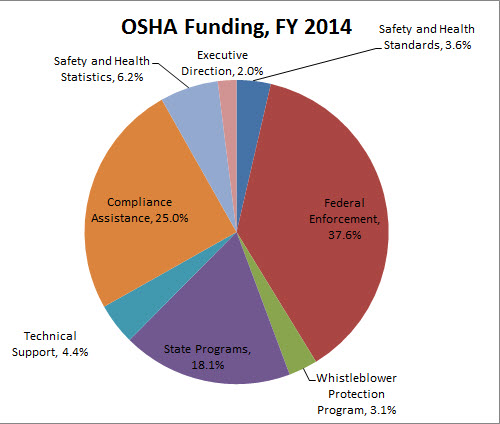The latest budget signed into law by President Obama includes $552.2 million in funding for OSHA, including approximately $208 million for enforcement. Although the total amount falls $18.3 million short of the $570.5 million the agency requested, the final budget fully funds OSHA’s requested enforcement dollars. Overall, the new funding levels represent an increase of $17 million, or 3.2%, over the funding OSHA received during the sequestration-impacted Fiscal Year (FY) 2013.
So what does OSHA plan to spend its money on in 2014? Here are the highlights:
- $207.8 million will be earmarked for federal enforcement activities. This amount is similar to the FY 2013 final spending levels because OSHA shifted its funds towards enforcement from other programs during sequestration.
- $143.9 million will be used for compliance assistance, including federal assistance, state consultation grants, and training grants.
- $100 million will be available for grants to states that operate their own occupational safety and health agencies.
- $34.3 million will be used for safety and health statistics.
- $20 million will be available for safety and health standards.
- $24.3 million will go towards technical support.
- $17 million will fund whistleblower protection programs.

OSHA says it plans to use its funding to advance its overall goals of securing safe and healthy workplaces and ensuring that workers have a voice in the workplace. In particular, the agency plans to focus on high-hazard industries and devote attention to the four leading causes of workplace death: falls, electrocutions, caught-in and caught-between incidents, and struck-by incidents. OSHA plans to use both enforcement and outreach efforts to work toward these goals.
According to OSHA’s 2014 Budget Justification, the agency plans to use its enforcement funding to conduct 39,250 inspections in 2014. These inspections will be targeted to find and address the most hazardous workplaces under the agency’s new weighted inspection system. In addition to focusing on serious hazards, OSHA plans to encourage its compliance officers and area offices to conduct complex inspections, such as those for Process Safety Management.
What it means for businesses
So are you likely to be inspected in 2014? The following is the list of OSHA’s current National Emphasis Programs. If any of these apply to your facility, make sure you’re in compliance with all applicable regulations, or you could face costly fines.
- Combustible Dust
- Hazardous Machinery (National Emphasis Program on Amputations)
- Hexavalent Chromium
- Occupational Exposure to Isocyanates
- Lead
- Nursing and Residential Care Facilities
- Primary Metal Industries
- Process Safety Management (Two programs: PSM Covered Chemical Facilities and Petroleum Refinery Process Safety Management)
- Shipbreaking
- Crystalline Silica
- Trenching and Excavation
In addition, the following list includes significant Regional Emphasis Programs. Click on your region to see what applies to you.
Region I (Connecticut, Maine, Massachusetts, New Hampshire, Rhode Island, Vermont)
- Combustible Dust
- Hazardous Machinery (National Emphasis Program on Amputations)
- Hexavalent Chromium
- Occupational Exposure to Isocyanates
- Lead
- Nursing and Residential Care Facilities
- Primary Metal Industries
- Process Safety Management (Two programs: PSM Covered Chemical Facilities and Petroleum Refinery Process Safety Management)
- Shipbreaking
- Crystalline Silica
- Trenching and Excavation
Region II (New Jersey, New York, Puerto Rico, Virgin Islands)
- Fall Hazards in Construction
- Logging
- Heavy Highway and Bridge Construction and Maintenance
- Natural Gas Drilling
- Metal Recycling
- Car Wash Establishments
- Hurricane Sandy Cleanup and Recovery
Region III (Delaware, Washington, D.C., Maryland, Pennsylvania, Virginia, West Virginia)
- Oil and Gas Service Industry
- Fall Hazards in Construction
- Department Store Industry
- Healthcare Industry
- Scrap Yards
- High Level Noise
- Health Hazards in the Fabrication of Metal Products
- Concrete Products
Region IV (Alabama, Florida, Georgia, Kentucky, Mississippi, North Carolina, South Carolina, Tennessee)
- Falls in Construction
- Landscaping/Horticultural Services
- Electrical Hazards
- Noise Hazards
- Construction
- Powered Industrial Trucks
- Methylene Chloride
- Federal Agencies
- Sharps Injuries in Urgent Care Centers, Medical Clinics, and Ambulatory Surgical Centers
- Sanitation and Clean-up Operations in Food and Kindred Products Industries
Region V (Illinois, Indiana, Michigan, Minnesota, Ohio, Wisconsin)
- Building Renovation/Rehabilitation
- Powered Industrial Vehicles
- Dairy Farm Operations
- Fall Hazards in Construction and General Industry
- High Rise Building Construction in Chicago
- Grain Handling Facilities
- Primary Metal Industry
- Federal Agencies
- Tree Trimming Operations
Region VI (Arkansas, Louisiana, New Mexico, Oklahoma, Texas)
- Upstream Oil and Gas Industry
- Construction
- Marine Operations
- Demolition Activities
- Work Zone Safety and Health
- Cranes in Construction
- Fabricated Metal Products Manufacturing
- Fall Hazards in Non-Construction Industries
- High Noise in Manufacturing
- Heat Illnesses
- Grain Handling Facilities
Region VII (Iowa, Kansas, Missouri, Nebraska)
- Logging and Sawmill Industries
- Powered Industrial Trucks
- Oil and Gas Operations
- Commercial and Residential Construction
- Grain Handling
- Noise and Respiratory Hazards
- Recycling and Scrap Hazards in General Industry Establishments
Region VIII (Colorado, Montana, North Dakota, South Dakota, Utah, Wyoming)
- Asbestos Abatement
- Noise and Respiratory Hazards in General Industry
- Logging Operations in Bark Beetle Incident Areas
- Roadway Work Zone Activities
- Oil and Gas Industry
- Fall Hazards in Construction
- Automotive Lists
- Grain Handling Facilities
- Automotive Services
Region IX (Arizona, California, Hawaii, Nevada, American Samoa, Guam, Northern Mariana Islands)
- Warehousing Operations
- Smelters
- Hotels, Casinos, and/or Casino Hotels
- Longshoring Activities
- Automotive Lifts
Region X (Alaska, Idaho, Oregon, Washington)
- Residential Construction
- Floating Seafood Processors
- Construction Fall Hazards (Idaho)
- Off-Shore Oil and Gas Drilling
- Logging (Idaho)
- Shipyard Employment Operations
- Logging Operations Under Federal Jurisdiction (Oregon and Washington)
- Construction
- Native Health Care Facilities
- Grain Handling
- Facility Support Management Service Contractors at Military Bases and National Parks
- Longshoring Activity
- Powered Industrial Trucks
- Cranes in Construction, General Industry, and Maritime Employment